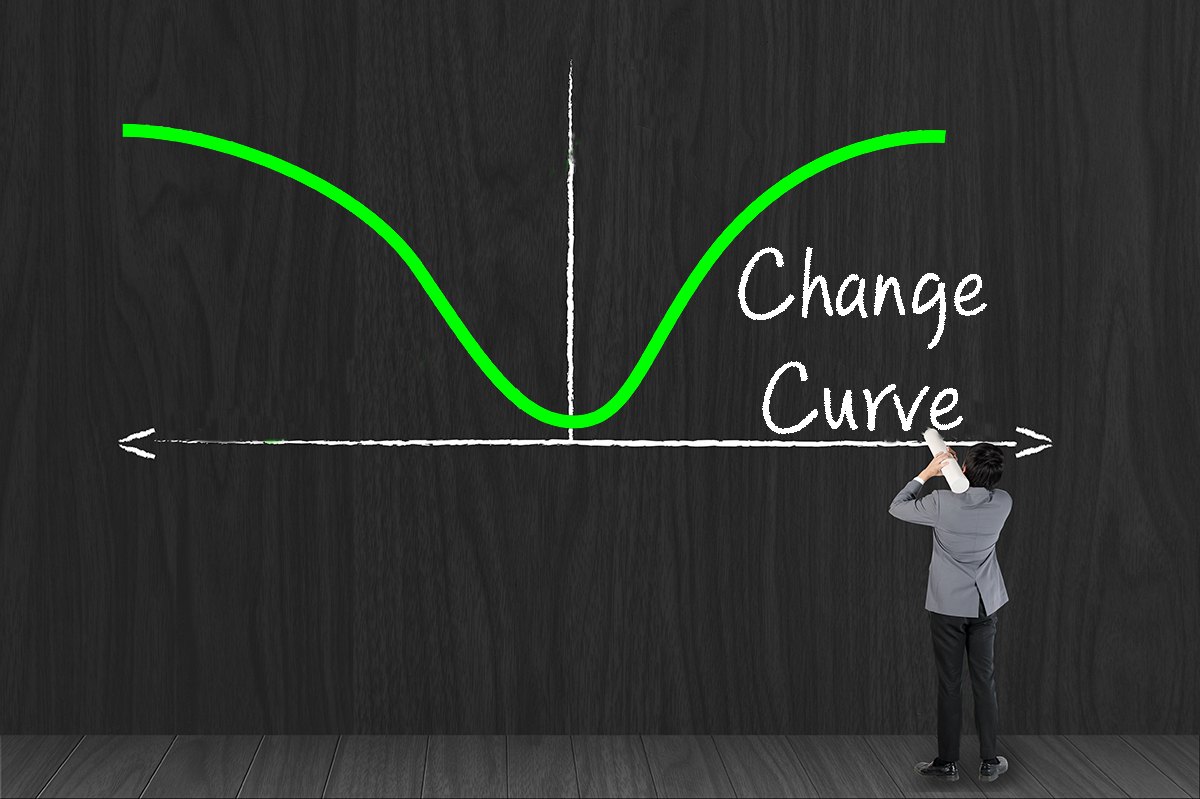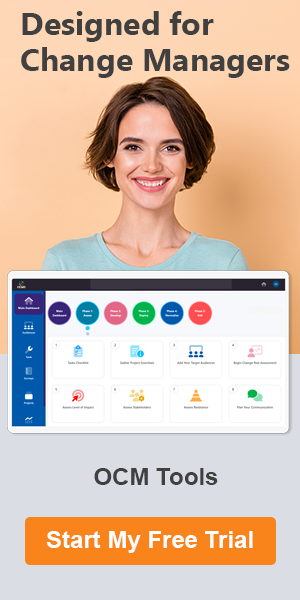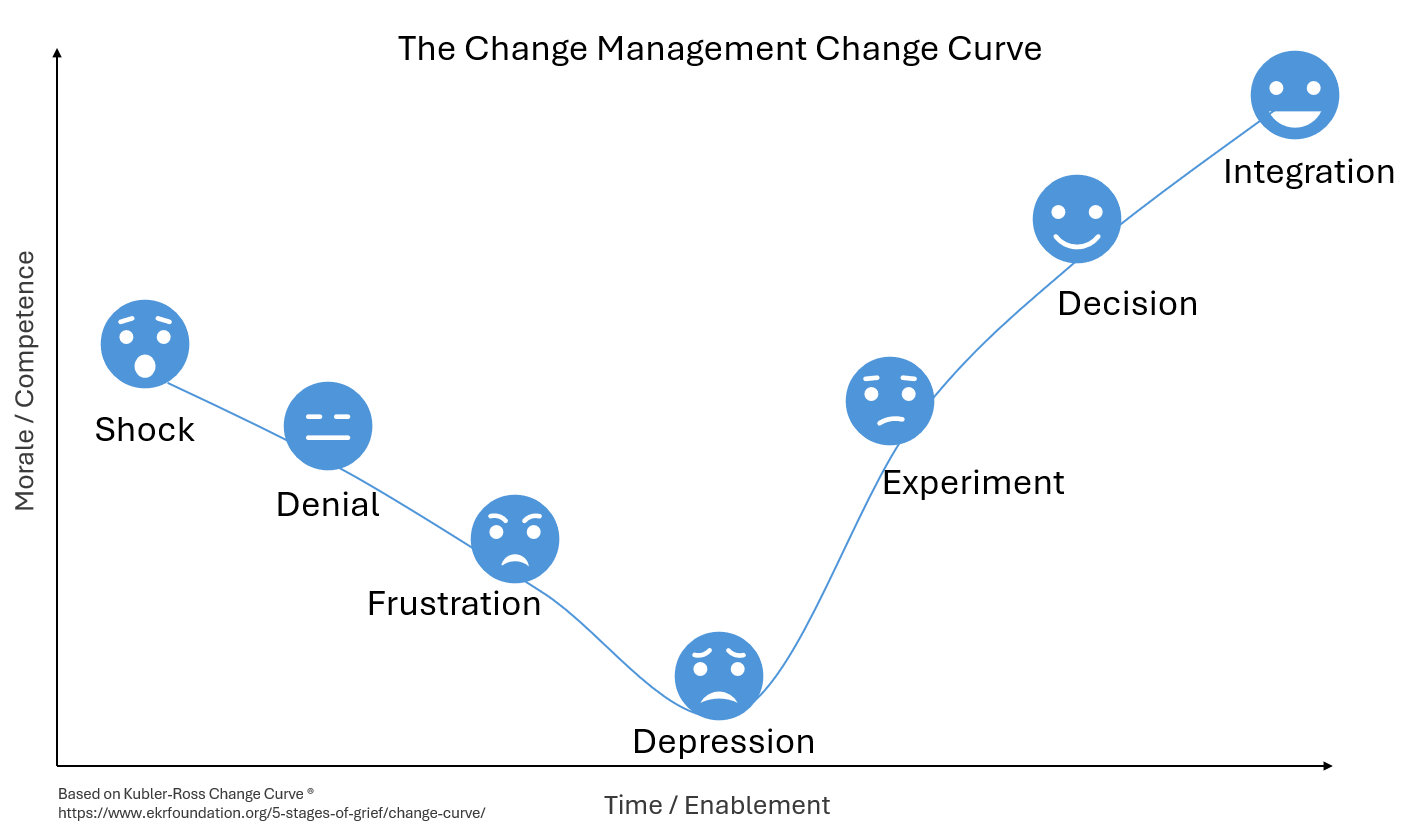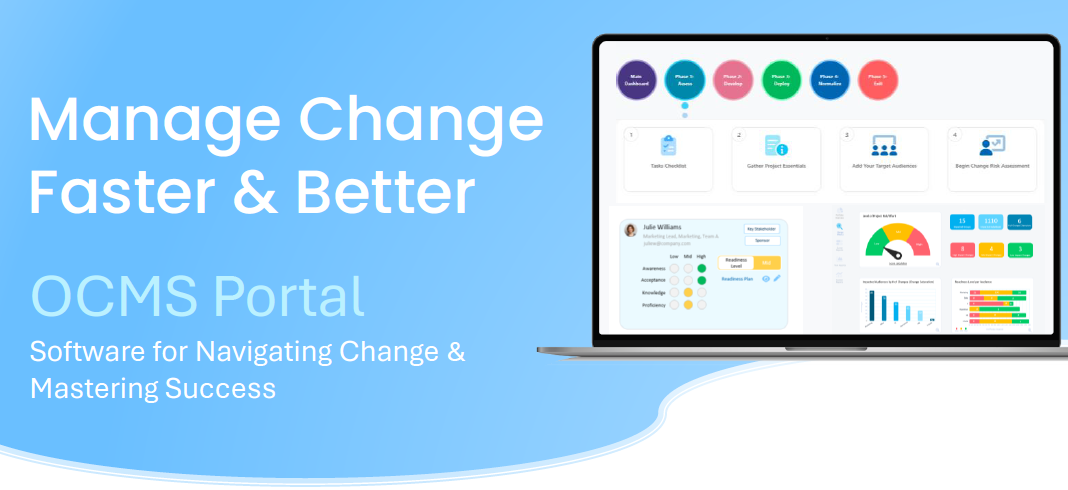How to Leverage the Change Curve Model in Change Management
Have you ever felt a pit in your stomach when your boss announces a major shift in the way things are done? You’re not alone. Change, even positive change, can be disorienting. But what if there was a map to navigate the emotional rollercoaster of transformation?
Enter the Change Management Curve Model. This powerful tool can help you understand the predictable stages of reaction to change, as you enable the organization for a successful transition. By harnessing the curve of change insights, you can turn a potentially bumpy ride into a smooth and successful transformation.

Below, we’ll discuss the change management curve model, exploring the several key stages individuals and teams go through when faced with change. We’ll also provide actionable tips to guide you through each stage, fostering a more positive and productive transformation experience for everyone involved.
Watch a summary below:
Story Highlights
|
What’s the Change Management Change Curve Model?
The Change Management Curve Model, originally derived from Elisabeth Kübler-Ross’s work on grief. The Kübler-Ross Change Curve® was developed in 1969 by as a way to show how people transition through change.
While the order and duration of these change curve stages can vary, understanding their core characteristics equips change leaders to anticipate and address challenges effectively. We’ll unpack each stage below, then we’ll explore practical strategies for helping people navigate the change commitment curve.
The Traditional Change Curve Stages include Shock, Denial, Frustration, Depression, Experiment, Decision, and Integration.
Let’s see how the change curve model above can be adapted into a Change Management Change Curve Model for organizational transitions.

7 Change Curve Stages During Organizational Transition:
- Shock – Surprise or shock when hearing about the changes.
- Denial – Disbelief and initial resistance, often due to a lack of awareness about the process and benefits.
- Frustration – Recognition that things will be changing in their work routine.
- Depression – Low mood and energy, due to initial resistance that often comes from fear of the unknown or anger.
- Experiment – Initial engagement with the changes, generally prompted by change management efforts.
- Decision – Learning how to work in the new situation, becoming more positive as proficiency and knowledge increase.
- Integration – Changes are integrated, the old ways of doing things is replaced by the new way, which becomes the “new normal.”
Change Curve Graphic
Do you have any questions about the traditional change curve model or the transition curve change management model? Please reach out and let us know!
OCM Strategies for Each Stage of the Change Management Curve
Next, we’ll look a little more into the change management graph for the curve of change and provide strategies for moving impacted stakeholders forward for successful change adoption.
Stage 1: Shock
The initial reaction to change is often a sense of shock. People might experience a temporary state of numbness or disbelief, struggling to grasp the full implications of the announced shift. This change curve stage is often characterized by a lack of focus and productivity as individuals grapple with the unexpected news.
Leadership Strategies:
- Communicate Clearly and Early: Provide a clear explanation of the change, its rationale, and its potential impact as soon as possible.
- Acknowledge Uncertainty: Validate employees’ feelings of shock and uncertainty. Let them know it’s okay to have questions and concerns.
- Create a Safe Space for Processing: Provide opportunities for open dialogue and information sharing to address initial anxieties.
Stage 2: Denial
As the initial shock subsides, some individuals may resort to denial. They might refuse to accept the reality of the change, clinging to the old way of doing things. This can manifest as resistance to using new tools, processes, or workflows.
Leadership Strategies:
- Be Patient but Persistent: While acknowledging denial, gently but firmly reinforce the inevitability of the change.
- Focus on the Future: Highlight the positive outcomes and potential benefits the change will bring.
- Offer Support and Resources: Equip employees with the tools and information they need to begin adjusting to the new reality.
Stage 3: Frustration
As the reality of change sets in, frustration often emerges. At this curve of change stage, individuals might become angry, questioning the effectiveness of the change or its necessity. This stage can be marked by decreased morale, increased conflict, and potentially lower productivity.
Leadership Strategies:
- Embrace Healthy Conflict: Allow for constructive dialogue to address concerns and identify potential roadblocks.
- Focus on Solutions: Work collaboratively with employees to find solutions and refine the change plan as necessary.
- Emphasize Transparency: Provide regular updates on the progress of the change and address concerns head-on.
Stage 4: Depression
After the initial frustration, some individuals may experience a sense of depression or apathy. They might feel discouraged, hopeless, or resigned to the change. This stage can lead to decreased motivation, withdrawal from work duties, and a decline in overall well-being.
Leadership Strategies:
- Offer Support and Encouragement: Acknowledge feelings of depression and provide support systems like employee assistance programs.
- Focus on Wins: Celebrate even small successes achieved during the change process to maintain momentum and hope.
- Reiterate the Importance of Each Employee: Remind individuals that their contributions are still valued and essential for a successful transition.
Stage 5: Experimentation
As individuals begin to accept the change, they may enter a stage of experimentation. This is when you see the line swing to the positive in the change curve graphic. They become more open to exploring new ways of working and trying out the changed processes. This stage is characterized by a willingness to learn and adapt to the new environment.
Leadership Strategies:
- Encourage Innovation: Foster a culture of experimentation and celebrate creative solutions to address challenges arising from the change.
- Provide Resources and Training: Equip employees with the necessary skills and knowledge to thrive in the new work environment.
- Offer Opportunities for Feedback: Create open channels for feedback to continually improve the implemented changes.
Stage 6: Decision
Following experimentation, individuals reach a point of decision. They either fully embrace the change and integrate it into their work routine, or they actively resist and potentially disengage from the process.
Leadership Strategies:
- Reinforce the New Way of Working: Integrate the new processes and workflows into standard operating procedures and performance metrics.
- Recognize and Reward Efforts: Acknowledge individuals who are actively embracing the change and making a positive contribution.
- Address Lingering Concerns: Openly address any remaining concerns and provide ongoing support for those who are still struggling to adapt.
Stage 7: Integration
The final change management change curve stage signifies a complete shift in mindset. Individuals are no longer just accepting the change; they are actively committed to it and see its value. They have not only adapted but potentially improved their workflows and performance due to the change.
Leadership Strategies:
- Celebrate Success: Recognize the collective effort that led to the successful implementation of the change.
- Look Ahead: Use the momentum gained to identify and plan for future improvements and transformations.
- Maintain Open Communication: Continue to foster open communication and solicit
Please let us know if you have any questions or feedback about the change management change curve diagram or the change curve model in general.
Beyond the Change Curve Stages: Considerations for Successful Projects
The Change Management Curve Model is a valuable tool, but it’s important to remember that change is rarely linear. Individuals may cycle back through earlier stages, and the pace of progress can vary. Here are some additional factors to consider for a successful transformation:
- Leadership Commitment: Visible and unwavering support from leadership is crucial for driving change acceptance and adoption.
- Change Champions: Identifying and empowering internal change champions can foster enthusiasm and provide peer-to-peer support.
- Effective Communication: Clear, consistent, and transparent communication throughout the change process is paramount.
- Change Management Methodology: Utilize a structured change management methodology to ensure a well-defined approach with clear objectives and outcomes.
- Metrics and Measurement: Track progress towards the desired state. This can provide the visibility you need to proactively address any issues.
The Human Side of Change: Fostering a Supportive Environment
Change management isn’t just about processes and procedures; it’s about people. Afterall, it’s people that are going through the change management change curve stages. Here are some ways to foster a supportive environment that facilitates smoother transitions:
- Empathy and Emotional Intelligence: Develop empathy and emotional intelligence as leaders to understand and address the emotional aspects of change for your team members.
- Psychological Safety: Cultivate a culture of psychological safety where individuals feel comfortable voicing concerns, asking questions, and admitting mistakes without fear of retribution.
- Individualized Support: Recognize that individuals will experience and respond to change differently. Offer personalized support and resources based on specific needs.
- Focus on Well-being: Prioritize employee well-being throughout the change process by offering stress management techniques and promoting work-life balance.
Do you have any questions about the change commitment curve or strategies to help people navigate through the curve of change? Please reach out and let us know.
The Importance of a Transition Curve Model
Why do people find the change management curve model so useful? What value does a curve of change model really provide?
Utilizing the change curve is a very useful process as it allows you to more effectively understand how people transition through a change.
Knowing where an employee, manager or group of impacted users are on the change management change curve will help you in developing and implementing effective change management plans to communicate, engage with, and support these individuals through the transition process.
Would you like to receive more helpful OCM tips and guidance beyond the change management graph of curve of change? Sign up for our monthly OCM newsletter here.
Conclusion: Navigating the Change Management Curve Model
Change, while often challenging, can also be an opportunity for growth and improvement – and it’s a necessity for growing companies. By understanding the Change Management Curve Model and implementing the strategies outlined above, you can equip yourself and your organization to navigate transitions more effectively.
Remember, successful change management is an ongoing process that requires continuous effort, clear communication, and a commitment to supporting your people through the journey. Embrace change as an opportunity to unlock new possibilities and achieve lasting success.
Practical Change Management Software
Helping employees in an organization navigate through the stages of the change management change curve model can be a daunting task. Make your life easier with a comprehensive software that supports all your OCM activities.
OCMS Portal is an all-in-one change management platform. It offers automated reports, insightful engagement plans, and all the tools you need to successfully manage all the transitions in your organization.

FAQ: Change Curve Model
The Change Management Curve Model, originally derived from Elisabeth Kübler-Ross's work on grief. The Kübler-Ross Change Curve Model was developed in 1969 by as a way to show how people transition through change.
When looking at a common change curve diagram, you'll see seven stages listed. These are: Shock, Denial, Frustration, Depression, Experiment, Decision, and Integration.
Utilizing the change curve is a very useful process as it allows you to more effectively understand how people transition through a change, so you can better target your OCM engagement.Where does the Change Curve Model come from?
What are the seven stages in the change curve graphic?
Why is knowing the change management change curve so helpful?
External sources: stock.adobe.com, The Kubler-Ross Change Curve(R): https://www.ekrfoundation.org/5-stages-of-grief/change-curve/
Note: Content on OCM Solution's ocmsolution.com website is protected by copyright. Should you have any questions or comments regarding this OCM Solutions page, please reach out to Ogbe Airiodion (Change Management Lead) or the OCM Solutions Team today. OCM Solution was previously known as Airiodion Global Services (AGS).



